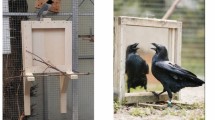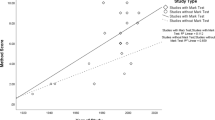Abstract
Despite half a century of research, few species have exhibited convincing evidence of mirror self-recognition. Several methodological objections to Gallup’s mark test have been raised, but empirical studies have shown that methodology does not adequately explain why most species fail to recognize themselves in mirrors. However, a potential issue was constantly overlooked: mirror ecological relevance. Although reflective surfaces in nature are horizontal, previous studies indeed used vertical mirrors. The present study revisited the mark test to address this issue in an experiment with capuchin monkeys (Sapajus apella). Additionally, a new procedure based on sticker exchange was designed to maximize mark attractiveness. Subjects were first trained to exchange stickers, habituated to being head-touched, and exposed to a horizontal mirror. Then, their mirror self-recognition was tested by surreptitiously placing a sticker on their forehead before requesting them to exchange stickers. None of the monkeys removed the sticker from their forehead in the presence of the mirror. In line with previous studies, this result suggests that capuchin monkeys lack the ability to recognize themselves in mirrors. Nonetheless, this modified mark test could prove useful in future studies, including investigation of interindividual variability of mirror self-recognition in self-recognizing species.



Similar content being viewed by others
Data Availability
No further data are associated with this article.
References
Anderson JR (1983) Responses to mirror image stimulation and assessment of self-recognition in mirror- and peer-reared stumptail macaques. Q J Exp Psychol 35:201–212. https://doi.org/10.1080/14640748308400905
Anderson JR (1996) Chimpanzees and capuchin monkeys: comparative cognition. In: Russon AE, Bard KA, Parker ST (eds) Reaching into thought: the minds of the great apes. Cambridge University Press, pp 23–56
Anderson JR, Gallup GG Jr (2011) Do rhesus monkeys recognize themselves in mirrors? Am J Primatol 73:603–606. https://doi.org/10.1002/ajp.20950
Anderson JR, Gallup GG Jr (2015) Mirror self-recognition: a review and critique of attempts to promote and engineer self-recognition in primates. Primates 56:317–326. https://doi.org/10.1007/s10329-015-0488-9
Anderson JR, Roeder J-J (1989) Responses of capuchin monkeys (Cebus apella) to different conditions of mirror-image stimulation. Primates 30:581–587. https://doi.org/10.1007/BF02380884
Bard KA, Todd BK, Bernier C et al (2006) Self-awareness in human and chimpanzee infants: what is measured and what is meant by the mark and mirror test? Infancy 9:191–219. https://doi.org/10.1207/s15327078in0902_6
Chang L, Fang Q, Zhang S et al (2015) Mirror-induced self-directed behaviors in rhesus monkeys after visual-somatosensory training. Curr Biol 25:212–217. https://doi.org/10.1016/j.cub.2014.11.016
Chang L, Zhang S, Poo M, Gong N (2017) Spontaneous expression of mirror self-recognition in monkeys after learning precise visual-proprioceptive association for mirror images. Proc Natl Acad Sci USA 114:3258–3263. https://doi.org/10.1073/pnas.1620764114
Collinge NE (1989) Mirror reactions in a zoo colony of Cebus monkeys. Zoo Biol 8:89–98. https://doi.org/10.1002/zoo.1430080111
de Waal FBM, Dindo M, Freeman CA, Hall MJ (2005) The monkey in the mirror: hardly a stranger. Proc Natl Acad Sci U S A 102:11140–11147. https://doi.org/10.1073/pnas.0503935102
Gallup GG Jr (1968) Mirror-image stimulation. Psychol Bull 70:782–793. https://doi.org/10.1037/h0026777
Gallup GG Jr (1970) Chimpanzees: self-recognition. Science 167:86–87. https://doi.org/10.1126/science.167.3914.86
Gallup GG Jr (1977) Absence of self-recognition in a monkey (Macaca fascicularis) following prolonged exposure to a mirror. Dev Psychobiol 10:281–284. https://doi.org/10.1002/dev.420100312
Gallup GG Jr, Anderson JR (2020) Self-recognition in animals: where do we stand 50 years later? Lessons from cleaner wrasse and other species. Psychol Conscious: Theory Res Pract 7:46–58. https://doi.org/10.1037/cns0000206
Gallup GG Jr, Wallnau LB, Suarez SD (1980) Failure to find self-recognition in mother–infant and infant–infant rhesus monkey pairs. Folia Primatol 33:210–219. https://doi.org/10.1159/000155935
Hall KRL (1962) Behaviour of monkeys towards mirror-images. Nature 196:1258–1261. https://doi.org/10.1038/1961258a0
Heschl A, Burkart J (2006) A new mark test for mirror self-recognition in non-human primates. Primates 47:187–198. https://doi.org/10.1007/s10329-005-0170-8
Inoue-Nakamura N (1997) Mirror self-recognition in nonhuman primates: a phylogenetic approach. Jpn Psychol Res 39:266–275. https://doi.org/10.1111/1468-5884.00059
Marchal P, Anderson JR (1993) Mirror-image responses in capuchin monkeys (Cebus capucinus): social responses and use of reflected environmental information. Folia Primatol 61:165–173. https://doi.org/10.1159/000156745
McGrew WC, Marchant LF (1997) Using the tools at hand: manual laterality and elementary technology in Cebus spp. and Pan spp. Int J Primatol 18:787–810. https://doi.org/10.1023/A:1026347913888
Murray LE, Anderson JR, Gallup GG Jr (2022) Mirror self-recognition in gorillas (Gorilla gorilla gorilla): a review and evaluation of mark test replications and variants. Anim Cogn 25:783–792. https://doi.org/10.1007/s10071-021-01592-3
Orkin JD, Montague MJ, Tejada-Martinez D et al (2021) The genomics of ecological flexibility, large brains, and long lives in capuchin monkeys revealed with fecalFACS. Proc Natl Acad Sci U S A 118:e2010632118. https://doi.org/10.1073/pnas.2010632118
Parker ST (1991) A developmental approach to the origins of self-recognition in great apes. Hum Evol 6:435–449. https://doi.org/10.1007/BF02435535
Paukner A, Anderson JR, Fujita K (2004) Reactions of capuchin monkeys (Cebus apella) to multiple mirrors. Behav Proc 66:1–6. https://doi.org/10.1016/j.beproc.2003.11.001
Povinelli DJ, Rulf AB, Landau KR, Bierschwale DT (1993) Self-recognition in chimpanzees (Pan troglodytes): distribution, ontogeny, and patterns of emergence. J Comp Psychol 107:347–372. https://doi.org/10.1037/0735-7036.107.4.347
Rajala AZ, Reininger KR, Lancaster KM, Populin LC (2010) Rhesus monkeys (Macaca mulatta) do recognize themselves in the mirror: implications for the evolution of self-recognition. PLoS ONE 5:e12865. https://doi.org/10.1371/journal.pone.0012865
Riviello MC, Visalberghi E, Blasetti A (1993) Individual differences in responses toward a mirror by captive tufted capuchin monkeys (Cebus apella). Hystrix 4:35–44. https://doi.org/10.4404/hystrix-4.2-3995
Roma PG, Silberberg A, Huntsberry ME et al (2007) Mark tests for mirror self-recognition in capuchin monkeys (Cebus apella) trained to touch marks. Am J Primatol 69:989–1000. https://doi.org/10.1002/ajp.20404
Shillito DJ, Gallup GG Jr, Beck BB (1999) Factors affecting mirror behaviour in western lowland gorillas, Gorilla gorilla. Anim Behav 57:999–1004. https://doi.org/10.1006/anbe.1998.1062
Suarez SD, Gallup GG Jr (1981) Self-recognition in chimpanzees and orangutans, but not gorillas. J Hum Evol 10:175–188. https://doi.org/10.1016/S0047-2484(81)80016-4
Suarez SD, Gallup GG Jr (1986) Social responding to mirrors in rhesus macaques (Macaca mulatta): effects of changing mirror location. Am J Primatol 11:239–244. https://doi.org/10.1002/ajp.1350110305
Swartz KB, Evans S (1991) Not all chimpanzees (Pan troglodytes) show self-recognition. Primates 32:483–496. https://doi.org/10.1007/BF02381939
Vanhooland L-C, Bugnyar T, Massen JJM (2019) Crows (Corvus corone ssp.) check contingency in a mirror yet fail the mirror-mark test. J Comp Psychol 134:158–169. https://doi.org/10.1037/com0000195
Visalberghi E (1997) Success and understanding in cognitive tasks: a comparison between Cebus apella and Pan troglodytes. Int J Primatol 18:811–830. https://doi.org/10.1023/A:1026399930727
Westergaard GC, Suomi SJ (1995) Mirror inspection varies with age and tool-using ability in tufted capuchin monkeys (Cebus apella). Hum Evol 10:217–223. https://doi.org/10.1007/BF02438974
Westergaard GC, Haynie MK, Lundquist AL, Suomi SJ (1999) Carrying, sharing, and hand preference in tufted capuchins (Cebus apella). Int J Primatol 20:153–162. https://doi.org/10.1023/A:1020592402625
Acknowledgements
The authors thank the University of Strasbourg and Silabe for supporting this research and providing animal care, and A. Panter and J. Lazarus for logistical help.
Funding
This research received no specific grant from any funding agency.
Author information
Authors and Affiliations
Contributions
Conceptualization: TC Methodology: TC HM Investigation: TC Supervision: HM Writing–original draft: TC Writing–review and editing: HM TC.
Corresponding author
Ethics declarations
Conflict of interest
The authors declare no conflict of interest.
Ethical approval
This non-invasive research complied with French legal requirements for the use of animals in research and EU Directive 2010/63/EU on the welfare of animals used for scientific purposes. As subjects voluntarily participated and were not food or water deprived, no ethical approval was required.
Additional information
Publisher's Note
Springer Nature remains neutral with regard to jurisdictional claims in published maps and institutional affiliations.
About this article
Cite this article
Calmette, T., Meunier, H. Revisiting the mark test for mirror self-recognition. Primates 64, 421–427 (2023). https://doi.org/10.1007/s10329-023-01065-w
Received:
Accepted:
Published:
Issue Date:
DOI: https://doi.org/10.1007/s10329-023-01065-w




